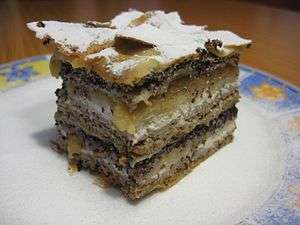Slovenian cuisine
The Slovenian cuisine (Slovene: slovenska kuhinja) is not uniform, but diverse and influenced by the diversity of Slovenian landscape, climate, history and neighbouring cultures. In 2006, the leading Slovenian ethnologists have divided the country into 23 gastronomic regions.[1]:15 Slovenian cuisine can be divided into town, farmhouse, cottage, castle, parsonage, and monastic Slovenian cuisine. The bourgeois Slovene cuisine incorporated elements of Austrian, German and French cuisines, whilst the dishes eaten by the working class were mostly a function of their professions (notably, mining and forestry). The first Slovene-language cookbook was published by Valentin Vodnik in 1799.
Foods and dishes
Soups are a relatively recent invention in Slovenian cuisine, but there are over 100. Earlier there were various kinds of porridge, stew and one-pot meals. The most common soups without meat were lean and plain. A typical dish is aleluja, a soup made from turnip peels and a well-known dish during fasting. The most common meat soups are beef and chicken soup. Meat-based soups are served only on Sundays and feast days; more frequently in more prosperous country or city households. Slovenians are familiar with all kinds of meat, but it used to be served only on Sundays and feast days. Pork was popular and common everywhere in Slovenia. Poultry also often featured. There is a wide variety of meats in different parts of Slovenia. In White Carniola and the Slovenian Littoral they eat mutton and goat. On St. Martin's Day people feast on roasted goose, duck, turkey, and chicken. In Lower Carniola and Inner Carniola, they eat roasted dormouse and quail. Until the crayfish plague in the 1880s the noble crayfish was a source of income and often on the menu in Lower Carniola and Inner Carniola.
Dandelion is popular as a salad ingredient in Slovenia and has been gathered in the fields for centuries. Even today dandelion and potato salad is highly valued. Since it can be picked only for a short time in early spring, much is made of it. Families go on regrat picking expeditions, and pick enough for a whole week. In the Middle Ages people ate acorns and other forest fruits, particularly in times of famine. Chestnuts were valued, and served as basis for many outstanding dishes. Walnuts and hazelnuts are used in cakes and desserts. Wild strawberries, loganberries, blackberries, bilbeberries were a rich source of vitamins. Mushrooms have always been popular, and Slovenians liked picking and eating them. There are many varieties. Honey was used to a considerable extent. Medenjaki, which come in different shapes are honey cakes, which are most commonly heart-shaped and are often used as gifts.
Protected foodstuffs and food products
As of June 2015, twenty-two Slovenian foods and food products are protected at the European level:[2]
- prleška tünka, a product from Prlekija in eastern Slovenia, made of minced lard and pork.
- Ptuj onion (ptujski lük), a sort of onion of a cordate shape, with red inspiration, whereas the edge has a more intensive purple hue.
- extra virgin olive oil from the Slovenian Istria (ekstra deviško oljčno olje Slovenske Istre), a little bitter and spicy oil with a strong fruit aroma, produced in the Slovenian Istria, contains a large amount of oleic acid and biphenols.
- Nanos cheese (nanoški sir), made of cow milk, hard, with small holes in the size of peas, a little sweet and spicy.
- Kočevje forest honey (kočevski gozdni med), produced in the wider Kočevje area.
- zgornjesavinjski želodec, an air-dried meat product from the Upper Savinja Valley, made of high-quality bacon and pork meat, filled in pig stomach.
- šebreljski želodec, produced in the areas around Cerkno and Idrija, made of high-quality bacon and pork meat, filled in pig stomach.
- Idrija žlikrofi (idrijski žlikrofi), small boiled dumplings filled with potatoes, onions, and lards.
- prekmurska gibanica, a pastry from Prekmurje, made of eight layers, contains poppy seeds, walnuts, apples, raisins, and ricotta fillings.
- Tolminc cheese (sir Tolminc), made of raw cow milk in the area of Tolmin, tastes sweet and spicy.
- White Carniola loaf (belokranjska pogača), a traditional flatbread from White Carniola.
- Karst prosciutto (kraški pršut), produced in the traditional way on the Karst plateau in southwestern Slovenia.
- Karst cured neck meat (kraški zašink), a cylindrically-shaped meat product from the cured pork neck meat in a casing
Traditional Slovenian dishes
Soups and stews
Vegetarian dishes
- Ajdovi žganci, žganci is a dish in Slovenian and Croatian cuisine. It's similar to polenta, although prepared with finer grains. Balthasar Hacquet (1739–1815) mentions that žganci was served with sauerkraut in Upper Carniola.[4]
- Aleluja
- Bezgovo cvrtje
- Čompe
- Fritaja (see also frittata) is a Croatian and Slovenian dish. Both are specialties in Istria. They are especially common in the springtime, as at that time there are many plants and vegetables such as wild asparagus, wild hops, herbs, chicory, tomatoes, young garlic sprouts and spices available to add to egg.[4] Fritaje are many times prepared throughout the year with ham, mushrooms, sausages, bacon, white or red wine.
- Frtalja
- Idrijski žlikrofi
- Jabolčna čežana
- Kaša is a cereal commonly eaten in Eastern Europe. At least a thousand years old, kasha is one of the oldest known dishes in Eastern European Slavic cuisine.[5]
- Krapi
- Maslovnik
- Matevž
- Medla
- Mešta
- Močnik is made from cereals such as buckwheat, maize, wheat, millet, rye, or oats in either milk, cream or soured cream.
- Njoki
- Smojka
- Štruklji
Meat dishes
Desserts and pastries

Prekmurska gibanica
Drinks
References
|
|---|
| | Northern Africa | |
|---|
| | Southern Europe | |
|---|
| | European regions | |
|---|
| | Western Asia | |
|---|
|